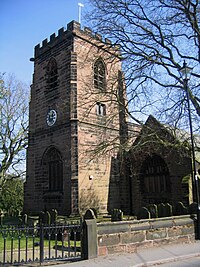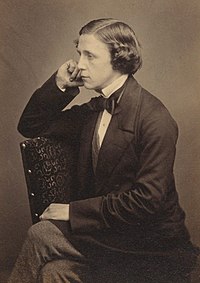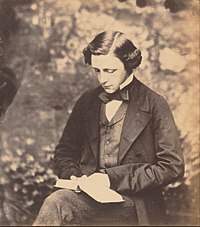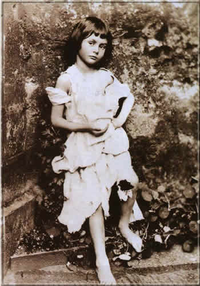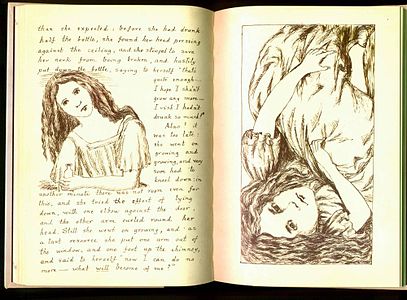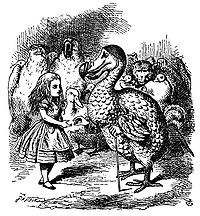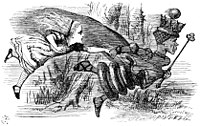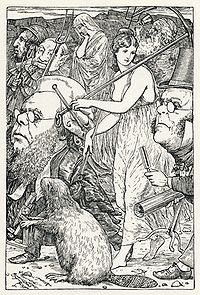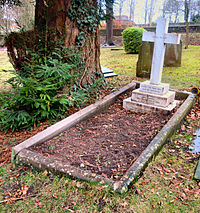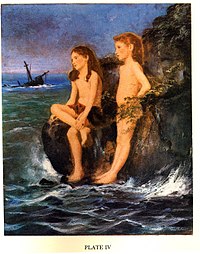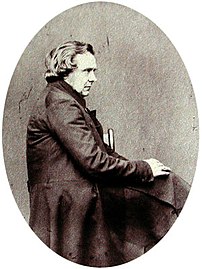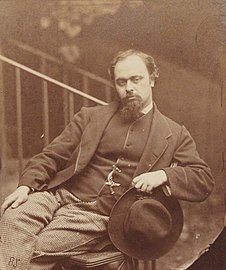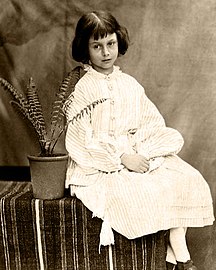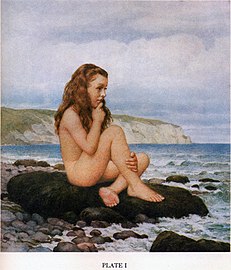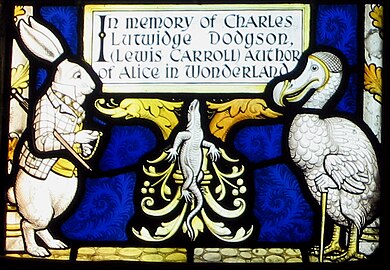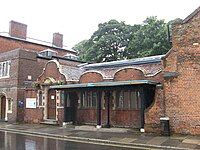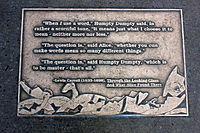Lewis Carroll
Lewis Carroll (born January 27, 1832 in Daresbury , County Cheshire , † January 14, 1898 in Guildford , County Surrey ; actually Charles Lutwidge Dodgson ) was a British writer of the Victorian era , photographer , mathematician and deacon .
He is the author of the famous children's books Alice in Wonderland , Alice Behind the Looking Glass (or Alice in Mirror Land ) and The Hunting of the Snark . With his ability to play on words , logic and fantasy , he managed to captivate large audiences. His works, known as so-called nonsense literature , have remained popular to this day and have not only children's literature but also writers like James Joyce , the surrealists like André Breton and the painter and sculptor Max Ernstor influenced the cognitive scientist Douglas R. Hofstadter . Carroll was also known as a photographer: like Julia Margaret Cameron and Oscar Gustave Rejlander , he was already practicing photography as art from the mid-19th century.
biography
origin
Dodgson, aka Carroll, came from a northern English family with Irish connections - conservative, Anglican, upper-middle class - whose members chose the military and church professions typical of their class. His great-grandfather, who, like his grandfather and father, was also named Charles, had risen to become a bishop in the Anglican communion . His grandfather died in December 1803 as a captain in the British Army (4th Dragoon Guards) when his two sons were still toddlers. He was stationed in Ireland and was shot dead while trying to meet an Irish rebel who had claimed to surrender at night. The older of his two sons, Charles Dodgson, born in 1800 and the father of Lewis Carroll, turned to the other family tradition and embarked on a spiritual career. He went to Westminster School , then to the University of Oxford . He was excellent at math and the classical languages; he graduated summa cum laude , was a lecturer (lecturer) in mathematics at Oxford University and a fellow of his college and was ordained deacon . That could have been the start of an outstanding career; for a higher office he would have had to be celibate . However, he married his cousin Frances Jane Lutwidge (1803-1851) in 1827, whereupon he retired to the inconspicuousness of a country pastor.
One of Lewis Carroll's favorite uncles, Robert Wilfred Skeffington Lutwidge (1802–1873), a brother of his mother, was inspector of the British Asylums for the Insane (Lunacy Commissioner) and died when a patient stuck a self-made nail in his head.
Childhood and youth
Charles Lutwidge Dodgson was born in 1832 in the small rectory in Daresbury , Cheshire , to the eldest son and third child. Another eight children followed, and all (seven girls and four boys) survived to adulthood, which was unusual for the time. When Charles was eleven years old, his father took over the pastorate at Croft-on-Tees , North Yorkshire , and the whole family moved into the spacious rectory, which was their home for the next 25 years.
Dodgson Sr., meanwhile, made a certain career within the Church: he published some sermons, translated Tertullian , became archdeacon of the Ripon Cathedral and interfered, sometimes influential, in the intense religious disputes that divided the Anglican community. He was a member of the Anglican High Church , an admirer of John Henry Newman and the Oxford Movement, and tried to convey these views to his children.
Charles junior did not go to school in the early years, but was homeschooled until he was eleven. His reading list was passed down through the family and is evidence of his outstanding intellect : for example, at the age of seven he read The Pilgrim's Progress by John Bunyan . His first biographer, the nephew Stuart Dodgson Collingwood, reported that his uncle had already gone to his father as a three-cheesy boy to ask him to explain the formulas on a logarithmic table and, after being told that he was still too young for that, insisted: " But please explain it to me! ”His relationship with his father was described as sober and factual, while his mother, who was the only son for a long time, cared for him lovingly and preferentially.
Charles invented a "train game" when he was eleven, inspired by the new, revolutionary technical invention of the railroad that he experienced in his Darlington neighborhood . The game with his siblings was played out according to precisely defined rules that he wrote down with sarcastic humor and that let the later Lewis Carroll see through. He also wrote plays for a puppet theater such as the tragedy of King John or the opera La Guida di Bragia , in which he brought the wide world into the walls of the rectory for himself and his siblings. Here the double world that will determine his life becomes visible: the staging, which is subject to precise rules, and the uncontrollable world outside.
At the age of twelve he was sent to a small private school in nearby Richmond in 1844 , where he already stood out for his mathematical talent. During this time he wrote poems in Latin, which were followed by stories in English. The headmaster, James Tate, attested that he had an extraordinary degree of genius, but advised the father not to let his son know about this superiority and to experience it for himself. Carroll suffered from this lack of affirmation all his life, and it could be a cause of his stuttering, lack of self-esteem, and his identity crisis .
A year later, however, Charles moved to Rugby School in Rugby , one of the most famous private schools in England, where he was obviously less fortunate. Ten years later, after leaving school, he wrote about his stay in the diary:
"I made some friends there [...], but I can't say that I look back on my life in public school with good feelings or that anything could move me to go through these three years again."
During his time at the unloved school, known for its disciplined system, Charles began to study literature extensively, for example reading David Copperfield by Charles Dickens and studying history books on the French Revolution . He published his literary attempts with drawings in the school magazine and in various family magazines of his family . In December 1849 he went again been given high praise by the school administration, from the Rugby School off to in 1850 at the University of Oxford to enroll .
The young adult Charles Dodgson was six feet tall, slender, with curly brown hair and blue eyes. At the age of 17 he had from a serious infection with whooping cough suffered, the result was a deafness of the right ear. The only serious handicap, however, was what he called his "insecurity," a stutter that had troubled him from early childhood and that plagued him for the rest of his life. Stuttering has always been a significant part of the myths that have grown up around Lewis Carroll. In this regard, for example, it has been claimed that he only stuttered in the company of adults but spoke freely and fluently in the presence of children. There is no evidence to support this claim; many children he knew remembered his stuttering, many adults did not notice it. Though the stutter bothered him, it was never so bad that he lost his ability to interact with others.
Studies - Mathematics tutor at Oxford
Dodgson attended his father's college, Christ Church , from May 1850 , where he studied mathematics, theology and classical literature. He had just been in Oxford for two days when he was called back home. His mother died of "encephalitis" (presumably meningitis or a stroke ) at the age of 47 .
When he returned to Oxford he found learning easy; the following year he graduated with top marks, and an old friend of his father's, Canon Edward Pusey, suggested him for a scholarship that enabled him to graduate .
Dodgson's early academic career oscillated between high ambition and lack of focus. In 1854 he was also preparing for ordination . A local paper, the Whitby Gazette in Yorkshire , was publishing some of his poems around this time. Due to laziness he missed an important scholarship, but because of his brilliance as a mathematician , after graduating in 1854, he was hired as a mathematics tutor at Christ Church in 1855 ; he was to fill this position for the next 26 years. He made a good income as a tutor, but he was bored with the work. Many of his students were stupid, older than him, richer than him, and most importantly, they were completely disinterested. They did not want to learn anything from him, he did not want to teach them anything, mutual apathy determined the daily dealings.
Carroll and the new medium of photography
His poet name, Lewis Carroll , which would make him famous, first appeared in The Train newspaper in 1856 in connection with a romantic poem, Solitude , which published some of his parodies, including Upon the Lonely Moor . Edmund Yates, the publisher of The Train , gave him the idea. This pseudonym is derived from his real name: Lewis is the Anglicized form of Ludovicus , the Latinized form for Lutwidge , and Carroll is the Anglicized form of Carolus , the Latin name for Charles .
The photography was invented in the 1830s, but it was the amateur photographer to the 1850s are not available; at that time, the development of the collodion wet plate made the photographic process easier. In March 1856, Carroll purchased a new camera and chemical materials in London for £ 15, a large sum at the time. His uncle Skeffington Lutwidge, whom he had visited as a child, and his friend from Oxford, Reginald Southey, with whom he made his first attempts at photography, influenced him in the new technical achievements, for which he was always interested.
Despite the chemical solvents evaporating, Carroll developed the photos in a corner of his room. In 1868 he got a larger studio in Christ Church and built his own studio above it, which was not completed until 1871. From that point on he had photographic equipment that was professional according to the time.
Carroll's best-known motif was Alice Liddell , the daughter of the Dean of Christ Church, Henry George Liddell . He had seen her through the window of his workplace in 1856 when she was playing with her sisters in the garden of the deanery. In April of that year he tried to photograph the church from this garden, which failed because of the poor lighting conditions. Carroll met and became friends with the siblings on this occasion.
In 1857 he earned his master's degree ( MA ) and met Alfred Tennyson , John Ruskin and William Makepeace Thackeray , whom he was later to portray photographically. He had connections to the Pre-Raphaelites , so he made friends with Dante Gabriel Rossetti and his family and met William Holman Hunt , John Everett Millais and Arthur Hughes , among others .
When Carroll was on vacation on the Isle of Wight , he met photographer Julia Margaret Cameron , who was also known for portraits of well-known people. Like Carroll, she was influenced by the motifs of Pre-Raphaelite painting. In 1861 he was ordained a deacon , he no longer had to take up the priesthood, which was fine with him because he feared he would stutter while preaching; so he has given few sermons in his life.
Carroll becomes a writer
Alice in Wonderland
On July 4, 1862, Carroll took a boat trip on the Thames with his friend Robinson Duckworth and three sisters, Lorina Charlotte, Alice and Edith Liddell, and told a story. When Alice Liddell asked him to write the story, the inspiration for his world-famous children's book Alice in Wonderland came about .
In February 1863, Carroll had completed the manuscript of Alice in Wonderland . It had turned into 90 pages in his meticulous little handwriting, with numerous blank spaces into which Carroll wanted to insert personally-made illustrations. It took almost two more years until he had finished the handwritten original version with the title Alice's Adventures Under Ground and gave it to Alice Pleasance Liddell in November 1864 with the dedication “A Christmas present for a dear child in memory of a summer's day”. His own drawings had their charm, but the amateur execution was not suitable for a printed edition, which Carroll did not want to rule out as a possibility.
The friendship between the Liddell family and Carroll broke up in June 1863. There can only be speculation about the causes, since the corresponding diaries from this period have been lost and Carroll's letters to Alice were destroyed by her mother. Speculations range from his alleged infatuation with Alice and the desire to marry her, to suspicions that a love affair with Alice's eldest sister Ina has been developing. Further explanations can be found in the reception section on the history of the diaries.
In Hastings he met the Scottish writer George MacDonald - it was the enthusiastic reception of his Alice by the young MacDonald children that finally convinced him of the publication of the work.
The Macmillan publishing house accepted the manuscript, which has since been greatly expanded, for publication in 1863. The book was published in 1865, first under the name Alice's Adventures Under Ground and then after extensions as Alice's Adventures in Wonderland with illustrations by the well-known cartoonist John Tenniel . The book was very well received and many enthusiastic readers immediately after its publication. These included the young writer Oscar Wilde and Queen Victoria .
As is known, Carroll stuttered, so that he occasionally introduced himself with "Do-Do-Dodgson". There are therefore suspicions that Carroll wanted to portray himself with the figure of the bird Dodo in his first work. The real dodo is a long-extinct bird that Alice first saw in the University Museum of Oxford and is currently on display there.
In 1886, after a long time, Carroll got in touch again with Alice Liddell, now married Hargreaves, and asked her permission to have a facsimile edition of his original manuscript made . This was published at the end of the year with an edition of 5000 copies; in the 1980s there was another reprint . Thirty years after Carroll's death, Alice Hargreaves released the original manuscript with the handwritten drawings for sale in 1928. It achieved high prices and did not return to England until 1946 through an initiative of the American National Library ( Library of Congress ) and bibliophile supporters. The Americans saw the handover "as a small token of appreciation that the English kept Hitler in check while we were still preparing for war". It is on display in the Manuscript Room of the British Museum in London.
Alice behind the mirrors
From June to September of 1867 led him to travel to Russia, and he began the manuscript Through the Looking-Glass ( Alice Through the Looking Glass ) to work, a continuation of the successful Alice in Wonderland . In the same year Bruno's Revenge was published, later it would become part of Sylvie & Bruno .
In 1868 Carroll's father died and the family had to move out of the Croft rectory. Carroll was now the new head of the family and was looking for a new home for his unmarried sisters. He found after many efforts, "The Chestnut", a house in Guildford in the county of Surrey , was to become the new family residence. The death of his father left him depressed for several years. His first mathematical publication appeared under the title The Fifth Book of Euclid . His second scientific publication appeared in 1879 as Euclid and his Modern Rivals .
In 1869 the title Phantasmagoria and Other Poems , in which several poems had been summarized, was published in small numbers.
For Alice behind the mirrors from 1871, Carroll wrote individual stories, fables or poems in contrast to his first book, which consisted of a continuous narrative. Despite some difficulties that had arisen with the first publication, he again hired John Tenniel as an illustrator. The inspiration for the book was again a girl named Alice. Carroll met Alice Raikes in August 1868 at her uncle's house in London and played them in front of a mirror. He put an orange in her right hand and asked in which hand Alice's reflection was holding the orange. "In the left" was the answer. The girl answered Carroll's question for a solution as follows: "If I were on the other side of the mirror, wouldn't the orange still be in my right hand?" Carroll refined this episode and shaped it into the story of Alice the mirrors .
From his family newspaper Mischmasch he took the nonsense poem Jabberwocky (in Christian Enzensberger's translation it is called Der Zipferlake ) for the edition, which begins with the first verse in mirror writing; this notation was originally intended for the entire book.
- Jabberwocky's first verse :
- Twas brillig, and the slithy toves / Did gyre and gimble in the wabe; / All mimsy were the borogoves, / And the mome raths outgrabe.
- It was digestible, and glassy scales / rotten gorkicht in the mind; / Gar elump was the Pluckerwank, / And they gave sweat fry. (Translation by Christian Enzensberger)
The egg on the wall called Humpty Dumpty , the twins Tweedledee and Tweedledum and the Red Queen appearing in them, who explains to the curious Alice: “In this country you have to run as fast as you can, are particularly well-known in Alice behind the mirrors if you want to stay in the same place. "
The Hunting of the Snark
In 1876 Carrols third great work was published, The Hunting of the Snark (The Hunting of the Snark) , a fantastic Nonsens- ballad . Henry Holiday created the illustrations . The poem is about a strange hunting expedition that sets out with care, hope and a completely empty sea map to catch a mysterious being called Snark. Among other things, it expresses the interesting view that something is right if it is said three times. The snark combines extraordinary properties. So he's handy when lighting lights, has a habit of getting up in the afternoon, doesn't take jokes and loves bathing carts . The Pre-Raphaelite painter Dante Gabriel Rossetti is said to have believed the poem was related to him.
It is legendary in the English-speaking world, but the poem is less well known in Germany. Nevertheless, there are several German translations of the "Agonie in eight convulsions", so the subtitle, including Die Jagd nach dem Schnark by Klaus Reichert and the Reclam edition Die Jagd nach dem Schnatz .
The Hunt for the Snark was also adapted in a number of variations for the stage and as a musical, for example by Mike Batt in 1987. Michael Ende translated the poem for the opera based on it by the composer Wilfried Hiller , which was performed on January 16, 1988 in the Prinzregententheater in Munich under the title The Hunt for the Schlarg was premiered.
The later years
Carroll was one of the writers who, unlike other colleagues, became very well-known and wealthy during his lifetime. In 1880, however, he abruptly ended his successful photographic work. The background has never been fully clarified. However, assumptions relate, among other things, to increasing problems with the parents of the little girls whom he wanted to photograph naked. Carroll was fascinated by young girls, mostly five to six years old, when he photographed them; they had to express liveliness, innocence and beauty in their charisma. The English painter Gertrude Thomson , who from 1878/79 onwards occasionally found young female models for him and was present at his photo shoots, described the props such as costumes, mechanical bears and rabbits in his studio and remembered the hours of fun together. She remembered meeting Carroll: "How his laugh sounded - like that of a child!" Together with him, she had a fondness for fairies and nymphs , who also appeared naked in her pictures.
He continued his work as a tutor at Christ Church College until 1881; an activity as a curator followed until 1892. The studio in the college continued to be his residence for the subsequent period, as the faculty of the college generally had a lifetime right of residence.
Sylvie and Bruno
Carroll's only novel, Sylvie and Bruno , which he worked on for ten years, was published in two volumes in 1889 and 1893. The illustrations are by Harry Furniss . Unlike in the Alice books, this is where children and adults meet, and for the first time in his work, a male main character appears. In contrast to his playful early narratives, the novel is governed by strict moral rules, and the levels of reality and fantasy are clearly discernible in contrast to his earlier works. One thing they have in common is the search for identity. Various interpreters have highlighted the parallels to the conflicts between the characters in the novel and those of the author. For example, in addition to the search for identity, the importance of the father, who otherwise did not play a role in any of Carroll's works, the superiority of the two older sisters, his belief in technology and a certain criticism of science are an issue. This work was denied the overwhelming success of its predecessors, probably because of the glaring differences to his earlier fantastic works. The English scholar Klaus Reichert sees in Sylvie and Bruno Carroll's desire to "see oneself as identical with oneself".
Lewis Carroll's death
Carroll thought of death many times in the last years of his life. Just before Christmas 1897, he went to see his sisters in Guildford, as he did every year. He had a cold, as he often does, from saving heating in his rooms at Christ Church College. At the turn of the year his health deteriorated. In the early afternoon of January 14, 1898, Lewis Carroll died of complications from pneumonia in the sisters' home, "The Chestnuts". Among the mourners was the painter Gertrude Thomson, with whom he had temporarily worked.
Lewis Carroll's grave plinth in Mount Cemetery, Guildford Cemetery, bears the inscription “Rev. Charles Lutwidge Dodgson ”in brackets below the addition“ (Lewis Carroll) ”- a testimony to his double life, which has accompanied him to his death.
Double life as scientist and artist
The mathematician and clergyman Charles Lutwidge Dodgson
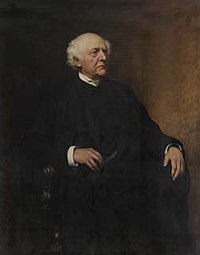
Carroll began teaching under his real name in 1855 at Christ Church College. As a math tutor he had to look after a group of students who did not make it easy for him. His tuition was not appreciated by the students, obviously Carroll lacked the humor that spices up his literary works. In a letter, he described that a tutor must be dignified and keep a distance from his students:
- “Otherwise he's not humble enough, you know. So I am sitting in the far corner of the room; the servant sits in front of the (closed) door; in front of the outer door (also closed) sits the servant; the sub-sub-servant sits half a flight of stairs below; and outside in the yard the student is sitting. The questions are shouted from one to the other, and the answers come back the same way - it's pretty confusing until you get used to it. "
This was followed by an absurd dialogue between student and teacher, which was conveyed through the servants and which gave rise to many misunderstandings. This letter already contains the satire of his later work as a writer, referring to the conservative orientation of the college, which was under the influence of the church. Reform proposals aimed to give the university authorities more power. Under the title Notes by an Oxford Chiel , Carroll published a collection of short satires on various matters of university policy at Oxford.
The new Dean Henry George Liddell , who was appointed in 1855 and Alice's father, had a reputation for being a reformer, but nothing fundamental changed during his tenure. Carroll himself took part in reform proposals in the scientific sense, but he was conservative on questions of theological traditions.
After he had given up his activity as a tutor in 1881, he was elected curator in 1882 . His job was to supervise the common room and organize activities. There, for example, Carroll demonstrated a magic lantern and provided information about the new world of technical media. In 1892 he gave up this position again.
In addition to his teaching activity, Carroll wrote various mathematical treatises and books on algebra , plane algebraic curves, trigonometry , two books on Euclid , a two-volume book Curiosa Matematica (1888, 1893), the second part of which is devoted to entertainment mathematics , and 1896 under his real name last work entitled Symbolic Logic . According to contemporary statements, Carroll was not an important mathematician, as formal and substantive errors were proven, but since the 1970s his contributions to logic in particular have been reevaluated through the examination of his estate (see reception). What made his works stand out was the presentation, so he conceived his main mathematical work Euclid and his Modern Rivals as a play, the discussion of mathematical questions was presented in dialogue form, with Euclid's spirit appearing in his defense. In the book he wanted to defend Euclid's old textbook in its original form for use in the classroom. He defends Euclid's treatment of the postulate of parallels , but in his first volume of Curiosa Mathematica from 1888 takes a completely different, own standpoint.
In the debate about new perspectives in science, Carroll took a conservative stance and stressed that science should not put into practice everything that is theoretically possible for it. For example, he rejected animal experiments (then: vivisection ), which he considered to be justified in only a few cases. In his 1875 essay, Some Common Misconceptions About Vivisection , he put forward 13 theses to support his point of view.
In the later years in particular, he invented puzzles, riddles and stories that were often based on numbers, but which basically posed the question of human existence, reality and staging. A series of brain teasers appeared in the London magazine The Monthly Packet from 1880 onwards . Ten episodes appeared, which he called "knots", with one or more mathematical-logical tasks each wrapped in a short story. These stories were later published in book form as A Tangled Tale . One of the puzzles he devised is the word ladder , which he calls doublets .
As a result of his admission to Christ Church College, Carroll had to undertake to receive training as a priest. In this way, he received a college scholarship and lifelong residence permit. He was ordained a Deacon in 1861 by Samuel Wilberforce , Bishop of Oxford . However, he did not embark on the priestly career his father wanted, who wanted his son to continue this family tradition, since he would have had to give up his beloved theater visits and, due to his tendency to stutter, he was not predestined to give sermons. However, his strict religious beliefs continued to shape his life.
Caroll was a member of the Society for Psychical Research , an association for the study of parapsychological phenomena.
The Photographer and the Girls - The "Carroll Myth"
When Carroll started photography, he wanted to combine his own ideas with the ideals of freedom and beauty to create the innocence of paradise where the human body and contact could be enjoyed without false shame.
For more than 24 years he had dealt with the medium of photography and created around 3000 images. Less than 1000 have survived time and destruction. An illustrated book by Roger Taylor and Edward Wakeling published in 2002 shows every photo that has stood the test of time, and Wakeling estimates that over 50 percent are young girls, while adults and families make up 30 percent, photographs of their own families make up 6 percent, topographical ones Recordings 4 percent and others such as self-portraits, still lifes and skeletons 10 percent.
Alexandra Kitchin, known as Xie, was his favorite model with over 50 shots from 1869 until 1880 when he stopped taking pictures. There she was shortly before her 16th birthday. His photos of naked children seemed lost for a long time, but four have survived. They were the source of suspicions about Carroll's pedophile tendencies; in this sense, Morton N. Cohen, among others, expressed himself in his biography of Carroll from 1995. In Carroll's collection of letters to little girls as well as in his diaries it becomes evident that he liked little girls beyond a socially acceptable level; however, he has never actually acted out pedophile tendencies.
The English writer Karoline Leach has a controversial point of view : in her book In the Shadow of the Dreamchild , published in 1999, she wants to prove that Carroll had unconventional relationships with several adult women at the time, for example with the artist Gertrude Thomson and the writer Anna Thackery . By "Dreamchild" is meant Alice Liddell. The French literary scholar Hugues Lebailly from the Sorbonne added that Carroll's biographers from earlier times had drawn the wrong conclusions and neglected socio-historical connections due to the no longer complete diary entries. The Victorian views on child nudity were not taken into account. At that time, many artists and photographers would have portrayed naked children. Such images expressed innocence and were very popular. The subject appeared on Christmas and vacation cards, and Carroll would have taken the photos for contemporary artistic and commercial reasons like his professional colleagues. Leach's catchphrase of the "Carroll Myth" still determines the literary-critical debates about Lewis Carroll's personality today.
- Photo gallery of celebrities and children
Samuel Wilberforce , Bishop of Oxford in Carroll's day, 1860
Xie Kitchin as a tea merchant, 1873, from the Wilfried and Ute Wiegand collection
Carroll's fantastic literature

The genesis of Alice in Wonderland points out that many details come from the author's imagination and unconscious . Alice seems like a dream, one narrative element joins the other; there is therefore no continuous narrative thread. Carroll has given appropriate information about his methodical approach, always noted the associations that came to his mind while writing and then added the text:
- “To begin, I sent my heroine down the rabbit hole with no idea what would happen next. [...] As I wrote it down, I kept adding new ideas that grew out of themselves and built on the original text. "
In contrast to the art fairy tales of the 19th century such as those by Dickens , Thackeray and Oscar Wilde , Carroll's poetic and aesthetic constructions take a back seat to his chains of association. As his biographer Thomas Kleinspehn emphasizes, references to individual passages to authors of world literature such as Cervantes and ETA Hoffmann are of little help. Although Carroll makes no direct reference to the contemporary texts, he was well versed in Victorian literature, as evidenced by his extensive library, the works of which it contains are well documented. This can be seen in the parodies built into his works, the origins of which are occasionally mentioned in Carroll's diaries. However, many are so strongly encrypted that they have only been discovered through meticulous literary work or are still waiting to be discovered. A classification of Carroll's unusual work is more likely to be in nonsense literature, which reacted with its counterworlds to the Victorian narrowness of society and its rationalism . Its most important representative was Edward Lear , who was twenty years older than him and is best known for his grotesque limericks in children's games and counting verses, which contrasted with the instructive Victorian children's literature. Whether Carroll knew Lear personally is controversial.
Carroll was fascinated by Charles Dickens since his youth. Dickens characters seem to reappear in his work in some animals. In addition to the influence of Tennyson and Thackeray, it was the representatives of the Pre-Raphaelites such as Dante Gabriel Rossetti , portrayed by Carroll, who tried to create an alternative world to the Victorian conventional and rational everyday life in their transfigured pictures. Carroll's works also determine a departure from the real world and, through their satirical and parodistic forms, form a kind of social criticism.
reception
Effect during lifetime
The actress Isa Bowman describes the impressions the artist made on her in The Story of Lewis Carroll , published in 1899 ; his silvery gray hair, which he wore far longer than was fashionable at the time, his deep blue eyes, the close shave, and the slightly unsteady gait, and she noticed that he was quite a well-known figure at Oxford. His clothes are a little eccentric, since he never wears a coat even in the coldest weather, and he has "the curious habit of wearing a pair of gray woolen gloves every season".
The American writer Mark Twain tells in his autobiography of a meeting with Carroll, "the author of the immortal Alice", that he was one of the quietest and most shy adult men he had ever met. Carroll sat quietly the whole time and only occasionally answered a question briefly. "I can't remember that at some point he went any further."
- Stained glass window dedicated to Carroll by Geoffrey Webb in Daniell Chapel, Daresbury, 1934
Carroll's effect on the surrealists
The surrealists were fascinated by the profundity and function of the dream in Carroll's work, and associative writing in particular found acceptance as an écriture automatique in surrealist literature. The surrealist painter and graphic artist Max Ernst created illustrations for Carroll's works from 1950.
Louis Aragon noted in his book Le surréalisme au service de la revolution in 1931, No. 3, that The Hunting of the Snark appeared at the same time as the Chants de Maldoror by Lautréamont and Arthur Rimbaud's Une Saison en enfer . He cites the massacres in Ireland, the oppression in the factories, the Manchester capitalism, which oppressed the people and sums up: “What had become of human freedom? It was completely in Alice's delicate hands, in which this strange man had placed it. "
Carroll's text Hummer Quadrille was included in André Breton's 1940 anthology of black humor . The surrealist sums up that Carroll's nonsense literature gets its meaning on the one hand from resolving the contradiction between the acceptance of faith and the practice of reason and on the other hand between poetic awareness and professional duties.
- “The mind can find a way out of the absurd with any difficulty. The willingness to affirm the absurd reveals the mysterious realm in which the children live. [...] It seems no less exaggerated to portray Lewis Carroll as a 'political insurgent' and attribute direct satirical intentions to his work. [...] All those who maintain a sense of rebellion will see Lewis Carroll as their first teacher in truancy. "
The versatile Alice
Alice in Wonderland is seen as a cultural icon . The book is considered a classic of children's literature, but is also associated with natural sciences, especially mathematics, astronomy, physics and computer science, with eroticism and canon literature . Lewis Carroll's stories were not only copied in children's books. The Victorian poet Christina Georgina Rossetti (1830-1894) and modernists such as TS Eliot (1888-1965), Virginia Woolf (1882-1941) and James Joyce (1882-1941) in his novel Finnegans Wake were inspired by the Alice books . Other writers and critics who made reference to Carroll's texts were Sir William Empson (1906-1984), Robert Graves (1895-1985) and Evelyn Waugh (1903-1966), more recently Julian Barnes , Stephen King and the postmodern critics Gilles Deleuze and Jean-Jacques Lecercle .
Hofstadters Gödel, Escher, Bach
In Douglas R. Hofstadter's book Gödel, Escher, Bach - an Endless Braided Band , the author describes the connection between his and Carroll's work under the heading Meaning and Form of Mathematics :
- “Both of my protagonists owe their existence to THIS two-part invention. Just as Lewis Carroll took certain liberties with Zeno's tortoise and Achilles, I allowed myself certain liberties with Lewis Carroll's tortoise and Achilles. In Carroll's dialogue, the same events take place over and over, only each time on a higher level. It makes a wonderful analogy to Bach's endlessly reduplicated canon. If one takes the joke out of Carroll's dialogue, a deep philosophical problem still remains: Do words and thoughts follow formal rules or not? This is the central problem of our book. "
Carroll's mathematical work from today's perspective
In logic, Carroll treated theorems of logic in the form of games in diagrams that resembled the later Venn diagrams , and used truth tables , as the unpublished manuscripts of the continuation of his Symbolic Logic (1896) show. Their second part, entitled Advanced , which was not published during their lifetime , was published in 1977. The third part (“Transcendental”) has not been preserved; like so many other things from his estate, he was probably burned. According to a table of contents assigned to the third part, it deals with the rules of logical derivation, "The Theory of Inference". With his "Method of Trees" he specified a procedure in the estate to show the provability of sentences of the one-digit predicate calculus . In doing so, he partially anticipated the work of Leopold Löwenheim , who proved in 1915 that this problem can be resolved (see also Löwenheim-Skolem's theorem ). The published part of his Symbolic Logic , on the other hand, was intended as an elementary textbook of classical syllogistic (i.e. elementary) logic, illustrated by diagrams. As such, it is still used by logicians in class today. Due to other work, he was also assessed more positively as a mathematician from the 1970s than was the case earlier, for example in his treatment of electoral systems (1884), in which he anticipated ideas from game theory . His work on mathematical puzzles has always been appreciated by Martin Gardner , the nestor of American entertaining mathematics , who reissued several of Carroll's books with annotations. In 1995 newly discovered Caroll “puzzles” were published in the estate.
The question of drug use
Some critics have found the unreal descriptions in the Alice books to be hallucinations of the author. The idea that Carroll was using drugs made him very popular in the 1960s underground culture, which invoked that one of the most famous writers used banned substances. Within the LSD movement, passages from Alice in Wonderland were interpreted as describing LSD trips or trips to other hallucinogenic drugs (psilocybin, mescaline). There are allusions in the book that indicate drug experiences. For example, the size of the protagonist Alice changes when she consumes mushrooms, cookies or liquids. The intoxicant LSD, which was consumed in the 1960s, did not yet exist in Carroll's time; its hallucinogenic effect was only discovered in 1943 by the Swiss chemist Albert Hofmann .
There has never been any evidence that Carroll used drugs. During Carroll's lifetime, laudanum was available as an often used pain reliever , which, as an opium-containing tincture , was able to induce intoxication in a sufficiently high dose. Carroll could possibly have taken it from time to time for his migraines , which are documented in his diary in 1880. There is also speculation that Alice's fantastic adventures may be influenced by the occasional pre-migraine aura. In this context, it should be mentioned that a seizure-like state in which people perceive themselves or their surroundings changed in a hallucinatory way is known as Alice in Wonderland syndrome .
The missing diaries
Four volumes and about seven pages are missing from Carroll's 13 diaries. The loss of the volumes and the pages is ultimately unclear. Many Carroll experts believe that family members' journals were removed to protect the family name, but there is no evidence to support this assumption. The missing material, with the exception of a single page missing, is attributed to the period between 1853 (Carroll was then 22 years old) and 1862.
A popular theory among many for the missing June 27, 1863 page is the presumption that the page was torn out to disguise Carroll's proposal of marriage to eleven-year-old Alice that day. A sheet of notes found in the Dodgson Family Archives in Woking in 1996 claims otherwise.
This paper, known as the cut pages in diary document , was compiled by family members after Carroll's death. It briefly summarizes the contents of two diary pages that are missing, including the sheet of June 27, 1863. The summary shows that Mrs. Liddell told Carroll that there were gossip stories about him, the Liddell family, and Ina, presumably Alice's older sister Lorina; the break with the family probably arose for this reason. Another interpretation was that Ina was also the shortened name of Alice's mother. This leads to the interpretation that Carroll's break with the Liddell family was unrelated to Alice.
Lewis Carroll's remaining diaries were acquired from the C. L. Dodgson Estate by the British Library in London in 1969 and are now kept there.
In the footsteps of Carroll in England
Christ Church and the Museum of Oxford
The Reverend Dodgon's place of work as a mathematician and clergyman at Christ Church in Oxford , where he had a studio in the northwest tower, was also the place where he wrote his stories as Lewis Carroll. He met his dean's children, Henry George Liddell, including Alice, his inspiration for his most famous book, Alice in Wonderland . The “Great Hall”, where he ate his meals, contains many of the mysteries of Wonderland , for example the “rabbit hole” is probably the door through which Dean Liddell enters the “senior common room” , entered. Liddell himself could be the "White Rabbit" because he was always late. There are guided tours for the visitor, on which he can visit, for example, the “Jabberwocky”, the “Cheshire Cat” and Alice's secret door to Wonderland .
The Museum of Oxford , which describes the city and its inhabitants from prehistoric times to the present day, has a special exhibition called “Looking for Alice”, which shows Alice Liddell's clothes and personal belongings, among other things.
Surrey History Center, Guildford Museum
Shortly after Carroll's death, his brother Wilfred had agreed that many of the bundled paper sacks from the rooms in Christ Church should be burned; the Dodgsons sold other papers at auctions. In 1965, the younger generation of the family donated many of their remaining memorabilia to the Surrey History Center and the Guildford Museum. The Surrey History Center in Woking therefore has an important archive on Carroll's life, consisting of documents relating to his childhood, letters and original photographs of his brothers, sisters and aunts. Among these papers are memories of 'child friends', a page with notes on the cut pages of the diary, and the corresponding letter from 1932 relating to the assumptions made by family members about the missing diary pages . Donations from other sources from the 1950s to the 1990s complete the collection.
In Guildford , the Dodgson family home after the father's death, the Guildford Museum hosts an exhibition about Victorian childhood. It contains toys made by Carroll and his siblings, such as a cow on wheels, a doll's house and a paper doll with clothes made by his sisters.
Others
Topics from Carroll's Alice books have been included in literature, film, pop music and computer games, among others. In 2007 the opera Alice in Wonderland was premiered at the Bavarian State Opera. A list of these adaptations can be found under the lemma Alice in Wonderland .
The Lewis Carroll Shelf Award was given from 1958 to 1979 to books that are believed to be of the same quality as Carroll's Alice in Wonderland . Examples are Inch by Inch by Leo Lionni in 1962 , Maurice Sendak's Where the Wild Things Are in 1964 , Astrid Lindgren's Christmas in the stable in 1970, and Snow White and the Seven Dwarfs by the Brothers Grimm in 1973 .
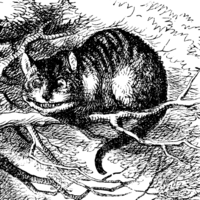
In Alice in Wonderland , a compound word was compared to a suitcase - and the term " suitcase word " was born. A synonym is "Portmanteau word", the English word for suitcase is portmanteau , derived from the French portemanteau . In a suitcase you collect different objects, in a suitcase word accordingly parts of words - and combine their meanings with them. About 70 years after Lewis Carroll, James Joyce created thousands of portmanteaus in his late work Finnegans Wake . In the title of his novel Der satanarchäolügenialkohöllische Wunschpunsch Michael exaggerated a suitcase word at the end of 1989.
The Cheshire Cat is a cat that appears in Alice in Wonderland ; when she disappears, her grin still remains. Then a concept of theoretical elementary particle physics was named, which is used in bag models and comes from, among others, Holger Bech Nielsen , it is called "Cheshire Cat Principle" (CCP). Snarks are a term used in graph theory (which play a role in the four-color problem ) and named by Martin Gardner after Carroll's poem.
The figure of the Red Queen from Alice behind the mirrors is the namesake for the Red Queen hypothesis on evolution . The hypothesis was put forward in 1973 by Leigh Van Valen . It says that a species in nature has to constantly become more efficient in order to maintain its current position.
In New York, the "Library Way" has been leading to the Stephen A. Schwarzman Building , the largest building in the New York Public Library (NYPL) , on East 41st Street between Fifth Avenue and Park Avenue since the late 1990s . 96 rectangular bronze plaques are embedded in the paving of the pedestrian path, which are dedicated to important writers and which contain quotations from their works. Lewis Carroll is represented with a plaque and a quote from Through the Looking Glass: And What Alice Found There .
In the fictional biography of William S. Barring-Gould about Sherlock Holmes it is mentioned that Lewis Carroll was the lecturer of Sherlock Holmes and recognized his special talent for combination.
Works (selection)
- Alice's Adventures in Wonderland. (1865).
- German Alice in Wonderland . In: The Alice Novels. Reclam, Stuttgart 1999, ISBN 3-15-059746-3 .
- Phantasmagoria and Other Poems . (1869)
- German phantasmagoria.
- Through the Looking-Glass, and What Alice Found There. (1871).
- German Alice in the mirror land . German by Helene Scheu-Riesz, decoration by Uriel Birnbaum, Vienna / Leipzig / New York, Sesam-Verlag 1923
- German Alice behind the mirrors. In: The Alice Novels. Reclam, Stuttgart 1999, ISBN 3-15-059746-3 .
- The Hunting of the Snark. (1876)
- dt. The hunt for the snitch. An agony in eight convulsions . (English German). Reclam, Ditzingen 1996, ISBN 3-15-009433-X (in other editions also Die Jagd nach dem Schnark or Die Jagd nach dem Schnai )
- Sylvie and Bruno. (1889).
- Sylvie and Bruno Concluded. (1893).
- German Sylvie and Bruno . dtv, Munich 2006, ISBN 3-423-13289-2 .
- Rhyme? And Reason? (1898)
- The Diaries of Lewis Carroll . New first edited and supplemented by Roger Lancelyn Green. Two volumes, London 1953, Westport, 1971.
- The Letters of Lewis Carroll . Edited by Morton N. Cohen. Two volumes. New York 1979.
- The literary oeuvre . Edited by Jürgen Häusser and Heinz-Juergen Häusser, newly translated by Dieter H. Stündel. Darmstadt.
- 1. Volume: Sylvie and Bruno. The story of a love. 1994, ISBN 3-89552-000-4 .
- Volume 2: Misch und Masch. Stories and poems. 1996, ISBN 3-89552-014-4 .
- Photographs . Edition Stemmle, Schaffhausen 1991, ISBN 3-7231-0407-X . (German English)
- Letters to little girls . Edited and translated by Klaus Reichert. With numerous photographs by the author. Insel Verlag, Frankfurt am Main / Leipzig. (Extended new edition: 1st edition. 1994, ISBN 3-458-33254-5 ; Komet, Leipzig 1994, ISBN 3-89836-300-7 )
- Diary of a trip to Russia in 1867. Edited by Felix Philipp Ingold . Insel, Frankfurt am Main 1999, ISBN 3-458-34289-3 .
- Illustrations by Max Ernst for works by Lewis Carroll: La chasse au snark (1950, 8 illustrations), Logique sans peine (1966), both Paris. The Hunting of the Snark ( Stuttgart 1968, 32 color lithographs) and Lewis Carrolls Wunderhorn (Stuttgart 1970, an anthology, selected by Max Ernst and Werner Spies with 36 color lithographs)
Mathematical works
- The Fifth Book of Euclid treated algebraically. (1858 and 1868)
- A Syllabus of Plane Algebraical Geometry. Oxford 1860.
- An Elementary Treatise on Determinants. Macmillan 1867.
- Euclid and his Modern Rivals . 1879, 2nd edition. Macmillan 1885, Reprint Dover 1973, 2004
- Editor Euclid. Books I, II. London, MacMillan 1882.
- The Game of Logic. Macmillan 1886 (New edition The Mathematical Recreations of Lewis Carroll: Symbolic Logic and The Game of Logic , Dover 1958)
- dt. The game of logic. published by Paul Good, Frommann Holzboog, Stuttgart-Bad Cannstatt 1998, ISBN 3-7728-1998-2 .
- What the Tortoise Said to Achilles . In: Min. 4, 1895, pp. 278-280.
- A Tangled Tale. (1885).
- German stories with knots . Insel, Frankfurt 1995, ISBN 3-458-32002-4 .
- Curiosa Mathematica. Volume 1: A new theory of parallels. London, Macmillan 1890.
- Curiosa Mathematica. Volume 2: Pillow Problems. 1893 (New edition The Mathematical recreations of Lewis Carroll: Pillow problems and A tangled tale. Dover 1958)
- Francine Abeles (Ed.): The mathematical pamphlets of Charles Dodgson and related pieces. Lewis Carroll Society of North America, New York 1994.
- William Warren Bartley (Ed.): Lewis Carroll's Symbolic Logic . Potter, New York 1977, 1986 (Volume 1 of 1896 and the unpublished second part)
Works on the web
- The Complete Works (PDF 38.19 MB) Reprint in the Arno Schmidt reference library of the GASL
- Alice's Adventures in Wonderland . (PDF 11.33 MB) Color edition in the GASL's Arno Schmidt reference library
- Alice's Adventure in Wonderland . Translated from the English by Antonie Zimmermann. (PDF 2.84 MB) Color edition in the GASL's Arno Schmidt reference library
- Stuart Dodgson Collingwood: The Life and Letters of Lewis Carroll at Project Gutenberg - The First Biography 1899
Exhibitions (selection)
- 1977: documenta 6 , Kassel
- 2003: Lewis Carroll Museum of Fine Arts, Houston
- 2003: Art Institute Chicago
- 2003: "Dreaming in Pictures" : Lewis Carroll International Center of Photography, New York
- 2003: Lewis Carroll , Art Institute Chicago
- 2005/2006: “useful - cute - museum. The photographed animal ” , Museum Folkwang, Essen
- 2011/2012: Alice in Wonderland , Tate Liverpool , then under the title Alice in Wonderland of Art , Hamburger Kunsthalle
Secondary literature
- Morton N. Cohen: Lewis Carroll. A biography . Reprint, Vintage Books, New York 1996, ISBN 0-679-74562-9 .
- Stuart Dodgson Collingwood: The Life and Letters of Lewis Carroll. T. Fisher Unwin, London 1899.
- Robert Douglas-Fairhurst: The story of Alice: Lewis Carroll and the Secret History of Wonderland. London: Vintage, 2015, ISBN 978-1-84655-862-7 .
- Martin Gardner : Lewis Carroll - All About Alice . Europa Verlag, Hamburg / Vienna 2002, ISBN 3-203-75950-0 (original title Annotated Alice . Annotated edition with illustrations by John Tenniel),
- Albert Schindehütte : Album for Alice. A tribute to Lewis Carroll . Hoffmann and Campe, Hamburg 1993, ISBN 3-455-06499-X .
- Phyllis Greenacre: Swift and Carroll. A Psychoanalytic Study of Two Lives . New York 1955.
- Thomas Kleinspehn: Lewis Carroll . Rowohlt, Reinbek near Hamburg 1997, ISBN 3-499-50478-2 .
- Karoline Leach: In the Shadow of the Dreamchild . Peter Owen Publishers. London 1999, ISBN 0-7206-1044-3 .
- Robert Taylor, Edward Wakeling: Lewis Carroll, Photographer . Princeton University Press, 2002, ISBN 0-691-07443-7 .
- Jenny Woolf: The mystery of Lewis Carroll: Understanding the Author of Alice's adventures in Wonderland. House Books, London 2010, ISBN 978-1-906598-68-6 .
- Edward Wakeling: Lewis Carroll: The Man and his Circle. London; New York, NY: Tauris, 2015, ISBN 978-1-78076-820-5 .
- Math
- The Mathematical Recreations of Lewis Carroll: Pillow Problems and a Tangled Tale . Dover Publications, 1958, reprint, ISBN 0-486-20493-6 .
- Robin Wilson : Lewis Carroll in Numberland. His Fantastical Mathematical Logical Life . Allan Lane, London 2008, ISBN 978-0-7139-9757-6 .
- Amirouche Moktefi, Article Lewis Carroll in Dictionary of Scientific Biography , 2008, Online
- Fiction
- Katie Roiphe : Enigmatic Alice. The story of Lewis Carroll and little Alice , translated from the American by Friedhelm Rathjen ; Original title: Still She Haunts Me . Europa, Hamburg, Vienna 2002, ISBN 3-203-81561-3 .
- Guillermo Martínez : The Alice in Wonderland Case . Detective novel, translated from Spanish by Angelica Ammar. Original title: Los crímenes de Alicia . Eichborn, Cologne 2020, ISBN 978-3-8479-0046-7 .
Web links
- Literature by and about Lewis Carroll in the catalog of the German National Library
- Works by and about Lewis Carroll in the German Digital Library
- Lewis Carroll in the Internet Speculative Fiction Database (English)
- Newspaper article about Lewis Carroll in the 20th century press kit of the ZBW - Leibniz Information Center for Economics .
- Search for Lewis Carroll in the SPK digital portal of the Prussian Cultural Heritage Foundation
- Lewis Carroll at photography-now.com
- Works by Lewis Carroll at Zeno.org .
- Lewis Carroll at Google Arts & Culture
- Website of the Lewis Carroll Society of North America with biography, texts and photo selection
- Biography in the Victorianweb
- Web page contains images of the complete original manuscript from 1864 with Carroll's drawings
- Peter Sager: Alice in Marketing Land . In: Die Zeit , No. 23/1998 (on the occasion of the 100th anniversary of death)
- Diploma thesis on Lewis Carroll 2008 (PDF; 4.29 MB)
- John J. O'Connor, Edmund F. Robertson : Lewis Carroll. In: MacTutor History of Mathematics archive .
- Surrey County Council on Carroll ( August 18, 2006 memento on Internet Archive )
- Information about Lewis Carroll on KinderundJugendmedien.de
Individual evidence
- ^ Stuart Dodgson Collingwood: The Life and Letters of Lewis Carroll , 1898. (TXT) on Project Gutenberg
- ^ Morton Cohen: Lewis Carroll, a Biography. Pp. 30-35.
- ↑ Biography of his uncle Robert Wilfred Skeffington Lutwidge
- ^ Morton Cohen: Lewis Carroll. A biography. P. 200 f.
- ↑ Thomas Kleinspehn: Lewis Carroll. Pp. 14-23.
- ↑ Kleinspehn, p. 25; quoted from Phyllis Greenacre: Swift and Carroll. A Psychoanalytic Study of Two Lives. P. 128.
- ↑ Collingwood, p. 30.
- ↑ Karoline Leach: In the Shadow of the Dreamchild . Chapter 2
- ↑ Karoline Leach: In the Shadow of the Dreamchild. 2nd chapter
- ↑ Morton Cohen: Lewis Carroll, a biography. P. 30.
- ^ Edward Wakeling: Lewis Carroll and his Photography. Archived from the original on July 8, 2006 ; Retrieved September 8, 2008 .
- ↑ Kleinspehn, p. 96.
- ↑ Morton Cohen: Lewis Carroll, a biography
- ↑ Kleinspehn, p. 74.
- ↑ Kleinspehn, p. 108 f.
- ↑ Peter Sager: Alice in Marketing Land . In: Die Zeit , No. 23/1998.
- ↑ Kleinspehn, pp. 73 ff.
- ↑ Kleinspehn: Lewis Carroll. P. 81 f.
- ↑ Kleinspehn, p. 80 ff.
- ↑ Kleinspehn, pp. 105, 117 ff.
- ↑ Kleinspehn, p. 90 f.
- ↑ Kleinspehn, p. 134 f.
- ↑ Stuart Dodgson Collingwood: The Lewis Carroll picture book . T. Fisher Unwin, London 1899, p. 198 f . ( archive.org ).
- ↑ Kleinspehn, p. 33 f.
- ↑ Kleinspehn, p. 37 f.
- ↑ Lewis Carroll: Some Common Misconceptions About Vivisection. 1875. In: Manuela Linnemann (Ed.): Brothers - Beasts - Automata. Harald Fischer Verlag GmbH, Erlangen 2000, pp. 209-218.
- ↑ Kleinspehn, pp. 31–44.
- ↑ Kleinspehn, p. 34 f.
- ↑ Linus Hauser: Critique of the neo-mythical reason. Volume 1: People as gods of the earth . Schöningh, Paderborn 2004, p. 261.
- ^ Edward Wakeling: The Real Lewis Carroll (April 2003). Retrieved September 10, 2008 .
- ↑ Sadi Ranson Polizetti: The Photography of Lewis Carroll. (No longer available online.) Blogcritics.org, archived from the original on December 8, 2015 ; accessed on November 27, 2015 .
- ↑ Kleinspehn: Lewis Carroll. P. 120; see. Richard Wallace: The Agony of Lewis Carroll. Melrose, Mass. 1990, p. 217 f
- ↑ carrollmyth.com/: The Carroll Myth. Archived from the original on July 8, 2011 ; Retrieved June 6, 2012 .
- ↑ Kleinspehn, p. 56 ff.
- ↑ a b Kleinspehn, p. 147.
- ↑ Kleinspehn, pp. 93, 148.
- ↑ Kay Voges: Alice in Wonderland. Uni Kiel, accessed on November 28, 2015 .
- ^ Douglas R. Hofstadter: Gödel, Escher, Bach. an endless braided band . 18th edition. Klett-Cotta, 2008, p. 50 (American English).
- ^ WW Bartley: Lewis Carroll's lost book on logic. Scientific American, January 1972.
- ^ WW Bartley: Lewis Carroll's Symbolic Logic. Clarkson N. Potter, New York 1977.
- ^ F. Abeles Lewis Carroll's Method of Trees - its origin in Studies in Logic , Modern Logic Volume 1, 1990, p. 25.
- ^ Francine Abeles: Lewis Carroll's Formal Logic. In: History and Philosophy of Logic. 26, 2005, pp. 33-46, doi: 10.1080 / 01445340412331311947 .
- ↑ Jerzy Pogonowski: Lewis Carroll's Resolution and Tableaux . (PDF; 3 MB)
- ^ Abeles, British Journal History of Sciences, Volume 19, 1987.
- ^ E. Wakeling (ed.), Lewis Carroll: Rediscovered Lewis Carroll Puzzles. New York 1995.
- ↑ LSD story. alice-project, accessed January 27, 2009 .
- ^ Lewis Carroll / Alice in the popular culture. www.lewiscarroll.org, accessed September 22, 2012 .
- ↑ Christoph Koch: 50 works of doping culture
- ↑ Leach, p. 48.
- ↑ Leach, p. 51.
- ↑ Leach, pp. 48-51.
- ↑ Leach, p. 52.
- ^ Dodgson Family Collection, Cat. No. F / 17/1. " Cut Pages in Diary ( Memento of the original from April 30, 2015 in the Internet Archive ) Info: The archive link was inserted automatically and has not yet been checked. Please check the original and archive link according to the instructions and then remove this notice. (For the discovery, see The Times Literary Supplement , May 3, 1996)
- ↑ Karoline Leach: In / the Shadow of the Dreamchild , pp. 170-172.
- ^ Places To Go - Alice In Wonderland. Icons of England, archived from the original on September 22, 2008 ; Retrieved September 9, 2008 .
- ^ Lewis Carroll at Surrey History Center. Surrey History Center, archived from the original August 18, 2006 ; accessed on November 27, 2015 .
- ^ Snarks at Mathworld
- ^ Matthew J. Boylan: The Road to the Library is Paved with Inspired Quotations. lj.libraryjournal.com, July 5, 2012, accessed May 5, 2014.
- ^ William S. Baring-Gould: Sherlock Holmes: The biography of the great detective from Baker Street. Deutsche Verlags Anstalt, Stuttgart 1978, p. 35 ff
| personal data | |
|---|---|
| SURNAME | Carroll, Lewis |
| ALTERNATIVE NAMES | Dodgson, Charles Lutwidge |
| BRIEF DESCRIPTION | British writer, mathematician and photographer |
| DATE OF BIRTH | January 27, 1832 |
| PLACE OF BIRTH | Daresbury , England |
| DATE OF DEATH | January 14, 1898 |
| Place of death | Guildford , England |



